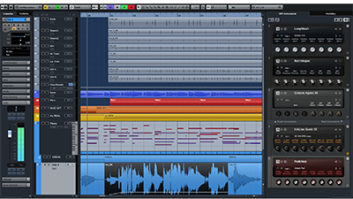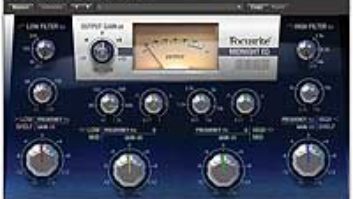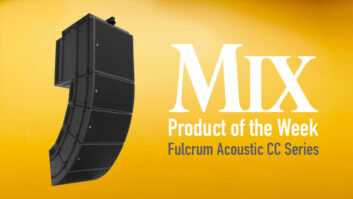The vast array of tools now available for recording, editing, processing and otherwise manipulating sound shows how far the applied science of audio-particularly in the digital domain-has developed during the past quarter-century. Yet for all our sophistication in using these tools, few audio professionals have a deep understanding of the science of sound itself, of why things sound the way they do in an actual acoustical environment. It’s a subject we don’t dwell on much until we suspect that something in our workspace is keeping us from getting the results we want. Then it’s time to call in an acoustical consultant, an expert who-we hope-can identify the cause of our sometimes vague discontent and propose a concrete plan of action.
Robert Rosati, principal designer at Rosati Acoustics + Multimedia in Boston, has consulted on numerous acoustic “upgrades.” Much of Rosati’s work involves creating new rooms for clients around the country, such as Source Sound Labs in New York, Red Diamond in Virginia and Eastern Sky Media in Florida. But for clients with existing rooms, he says, “the number one concern is uncertainty about the accuracy of control-room monitoring. They have concerns or skepticism about whether or not they are actually hearing what is going down on tape or disk.”
In most cases, Rosati says, the client’s questions revolve around the relationship between the sound of the mix in the control room and in the outside world, and a few specific areas often seem to come up: “How true is the tonality of instruments in the mix? How is the overall spectral balance of highs vs. mids vs. lows? Too thin? Too muddy? How is the relative balance of instruments? Is the mix too wet or too dry? Are instruments panned too far out or too crowded?”
The acoustic consultant’s job naturally goes beyond simply answering a client’s questions about his or her mixes. If there is a problem with the sound in a room, its cause must be found and a solution proposed. Depending on the cause-and the budget available to fix it-the solution might vary from correcting bad setup practices to refurbishing room treatment to tearing down walls. Luckily, many problems can be solved with some kind of “makeover” rather than a full-scale rebuild.
“Low-frequency sound isolation comes up again and again these days, from mix rooms and project studios to home theaters,” says George Augspurger of Perception Inc., an acoustical consultant whose clients include Sony Music Studios in New York City, The Enterprise in Burbank, Calif., and Fox TV Network in Los Angeles. “Unless you find something like holes in the walls that you can plug, you are dealing with a structural problem. There is very little you can do about it in terms of a makeover.”
Other problems that may require more structural solutions, Augspurger says, include stereo imaging. “You need a room that, at least in the front part, is symmetrical,” he says. “You can’t really do too much about that in a makeover. And for smooth low-frequency response, the room has to have a reasonable amount of volume, so you can’t work in a closet. But once you get past those basic things, then nine times out of ten you can make a room workable within its existing structure.”
Rosati agrees, pointing out that “acoustical problems caused by unwanted reflections can be addressed relatively easily, without significant down time. And monitoring system problems can be solved rather quickly with good evaluation techniques.”
Ears and Analyzers
While the range of sophisticated testing gear has grown in recent years, careful listening remains at the core of the evaluation process. “One of the most versatile and robust testing devices is a trained and experienced set of ears listening to familiar program material,” says George Hallowell, vice president of Studio Pacifica in Seattle. The company’s projects include post suites for Mackie, Electronic Arts and Glenn Sound, as well as rooms at Ultrasonic Studios, Jungle Studio and Bayside Recording. “Listening is also often the least expensive approach. And in the end, it’s the engineer and client ears that will determine the success or failure of an improvement anyway.”
Augspurger puts his initial emphasis on listening, as well. “The listening always comes first,” he says. “The point of measurements is to identify a problem that you can already hear. If you rely on measurements alone, you can easily be misled.”
Augspurger illustrates the point with an example that he says is nearly universal. “If you have a mix or mastering room that looks beautifully flat and smooth on a 11/43-octave analyzer, the room will almost always sound as if it has no bass. So first I’ll do a lot of playing around to try to get a tighter, punchier, heavier bass sound, and then I’ll go back and see what I’ve done according to the measurements and use that as a guide for further adjustment.”
For his analysis sessions, Rosati has built up what he calls his “standard” set of CDs. “They represent a wide gamut of musical qualities,” he says, “including percussive sounds, acoustic piano, detailed cymbal and acoustic guitar work, brass, strings, delicate highs, thunderous lows, and a wide range of imaging examples and highly dynamic passages.”
Although listening comes first, testing also plays a vital role. The key, Rosati says, “is selecting the appropriate measurements, properly quantifying the problems and interpreting the results. The precise analysis and measurement equipment depend on the situation. It may include a digital RTA [real-time analyzer], a TEF [time, energy, frequency], TDS [time delay spectrometry] machine, a digital SPL meter, an accelerometer for vibration pickup, a noise leakage tester, an oscilloscope, computer-based hardware, modeling software, and analysis software, both industry-standard and custom.”
Is It Acoustics?
One benefit of test measurements is that they help convert the subjective experience of the room’s users into something objective and quantifiable. But the question of how to address the problems revealed requires not only measurements but also experimentation and troubleshooting. In some cases, the root cause turns out to have little to do with acoustics.
“Let’s say an engineer points out that the low end sounds thin,” Rosati explains, “and a general measurement confirms the low end exhibits a highly irregular frequency-response curve. What’s the cause? Is it a weird room tuning, an acoustic problem, is it driver-based, or is it an electronics problem-equalizer, crossover, power amp or wiring? In various rooms we have actually discovered a low-frequency driver not working correctly, crossover component failure, equalizer misadjustment, the threshold set too low on an LF limiter, LF out of phase, a console capacitor acting as a highpass filter, and a room that is too large and/or absorptive for the monitor system.”
Fatigue in the monitor drivers is particularly common, Rosati adds. Additional, nonacoustic problems, such as poor solder joints, are often difficult to isolate and can contribute to less-than-ideal system response. But other common problems can be spotted by a consultant at first glance.
“One of the most common and avoidable problems is the placement of near-field monitors horizontally on the bridge of the console,” Hallowell says. “It creates a reflection off the hard console surface that mixes with the direct signal from the speaker in the first few milliseconds, whereas research has shown that the time between the direct signal and the first reflections should be about 20 milliseconds. Moving the speakers onto speaker stands away from the engineer often improves the sound. And orienting the speakers vertically minimizes time delay differences between tweeter and woofer as the engineer moves side to side. Also, the speaker-boundary effect between near-field monitors and the control room walls is often ignored, even though there are easily available software modelers, such as the RPG Optimizer, for predicting this effect.”
Beyond the effect of near-fields placement on their own sound, there is also the effect of near-fields on the sound of the mains. “I always elevate the large monitors to at least 4 feet,” Augspurger says, “because you know that the person is going to have one or two sets of near-fields, and otherwise, they can completely block the mains.” He also advises designing oversized main-speaker soffits so that there is some flexibility for experimentation with speaker placement once all the gear is settled in the room.
Flexibility is also important in the placement of consoles, outboard gear and tape machines. “Sometimes you can make a dramatic difference in a room simply by moving a console forward or back a few inches,” Augspurger says. “Unless you have a trench and service loop that can accommodate that movement, however, you’ll never know. As for large tape machines, people are getting those out into machine rooms or machine closets. But especially in production rooms, you still have piles of equipment that are partially blocking the speakers. It can be a real problem when you have a small work area with a ton of equipment that you are trying to operate.”
Even if outboard gear isn’t blocking direct sound it can still create a problem with reflections. “We’ve seen a number of rooms that have a large equipment rack directly behind the engineer,” Hallowell says. “With the rack angled upward, the sound reflecting off the hard surface of the equipment comes back to the engineer immediately and undiffused.”
Time for Treatment
Once issues such as monitor misalignment or equipment placement have been eliminated or addressed, room treatment comes to the fore. “Sometimes the room is good, and the monitoring system is inadequate for the studio’s needs,” Rosati says. “More often, the room’s acoustics require work, and very often, both the acoustics and monitoring system need tweaking. Extensive problems may require removing much of the existing treatments and traps and installing new absorption components, as well as adding diffusors and fabricating custom bass-management elements.”
One of the most common acoustic problems, Hallowell says, is unevenly distributed frequencies of absorption, caused by designing reverb time as an average rather than as a smooth curve over the full audible frequency range. “We renovated one room several years ago that was primarily treated with carpet and 1-inch-thick absorption applied directly to the walls,” he says. “There had been no thought given to mid- and low-frequency absorption. Needless to say, even though the overall reverb time average was about right, the room was very bass-heavy. Our solution was to design tuned mid- and low-frequency absorber areas to replace portions of the 1-inch treatment.”
While control rooms are most often cited as the area of concern, Rosati says studios are not immune to their share of problems. “If recording particular instruments is almost impossible without major hassles-changing mic types and positions, setting up many gobos, hanging blankets everywhere, moving around the room, patching in a rack of gear-then the room should be checked for acoustic problems. Of course, you should check your mics first, but some rooms do require acoustic signature modifications.”
Hallowell adds that acoustic problems in studios may be less noticeable because engineers aren’t always hearing a fixed position in the room. “The location and type of mic and instrumentation used in the studio will change the perception of the room acoustics,” he says. “But use of the room over an extended period will begin to expose any problems of flutter echo, mode buildup or uneven frequency response in certain areas that were not obvious at first.”
Noise leakage-in and out-is also a common studio problem, particularly with today’s lower digital noise floors. And while isolation may be the toughest studio problem to solve without a rebuild, it pays to first explore all the other possible solutions.
“We worked on a noise isolation concern several years ago that involved sound leakage between studios within the same building,” Hallowell recalls. “Careful examination and testing showed that the walls between the rooms were performing up to their original design. But the noise was flanking these walls by traveling down a thin zone between the building exterior and the first isolation wall running the entire length of the building. Also, a number of penetrations had been made over the years in the ceiling of one of the studios, and they had not been properly sealed. In this instance, the solutions were fairly simple once the source of the problem had been tracked down.”
As important as isolation is in commercial facilities, it can be even more of a concern in project studios, often located in residential settings. Unfortunately, isolation is only one aspect of studio design that is often found lacking in the project setting. “We are more likely to see poorly proportioned rooms and incorrectly applied absorption and diffusion in project studios,” Hallowell says. “Budget and space constraints may be unavoidable, but there is no reason not to research and design your facility carefully, or to retain a designer that can help you in the process. It actually may not cost any more to achieve much better performance.”
Changing With the Times
While Hallowell says project studios seem to more often exhibit specific problems related to insufficient original design, commercial facilities are more often made over to adapt to new tastes or a new purpose. “We are most frequently called in because of changing desires, uses or technology,” he explains. “Theories change, styles change, uses change and technology changes. In the mid-1970s, studios were often dark, moody, acoustically dead spaces. What was considered a good room acoustically in 1975 may not be appropriate today.”
One common type of adaptation is adding sound-for-picture capabilities to an existing music room. “We have implemented significant design changes to accommodate video projection equipment,” Rosati says. “Owners do not necessarily want to see the video gear at all times, so control rooms are designed to be easily convertible from audio-only to ‘mix-to-pix.’ Projector noise emissions and placement of the speakers have come up as common issues to solve. Installing a surround speaker format is sometimes tricky due to the existing room geometry and equipment placement.”
Hallowell agrees that 5.1 monitoring-for picture or pure music applications-can add to the challenge of reworking an existing room. “The ITU-R standards for multichannel sound systems call for placing surrounds at 110 degrees off the room axis,” he says, “which coincidentally is a position often used for the door in stereo control rooms. A number of new commercial rooms are instead electing to place the surround monitors in the rear corners of the control room, making a sort of ‘X’ pattern with the front left and right speakers. In a large control room, that may require compensation for time delay in the distance from the listening position.”
The bottom line is that the solutions to acoustic problems-new or old-are as varied as the rooms in which they are found. Consequently, there’s no magic fix that yields “perfect” sound. The most important thing to keep in mind, Rosati says, is to “quantify the problems before you tackle the fix. Know exactly what you are dealing with. And don’t throw money at a problem, spend it wisely.”
For his part, Augspurger says it is crucial that you spend some time experimenting before finalizing the room. “If everything is set in advance, it may or may not be as good a sound as you can get out of the space,” he says. “But I can tune a room acoustically with some packing blankets and scraps of Masonite. Then once we know how to get the room to sound the way it ought to, you can worry about spending time on making it look good.”





